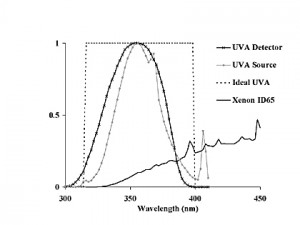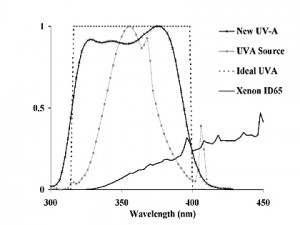7.6 Photostability
The current ICH (International Conference for Harmonization) guidelines specify that drug and drug products must be photo-tested to ensure that exposure to light does not cause photochemical degradation of the product or packaging. The product under test must receive a measured dose of both UV-A (200 watt-hours per square meter) and Visible (1.2 million lux-hours) optical radiation exposure. This requires both radiometric and photometric measurements in terms of illuminance in lux and UV-A (315 nm to 400 nm) irradiance in W/m2 multiplied by exposure time in hours.
It is important to note that total or absolute UV-A is implied. No effective UV-A spectral function is specified. Ideally for total UV-A measurements, the perfect broadband UV-A detector would have a flat square-wave spectral shape starting at 315 nm to 400 nm for 100 % response at each wavelength across this spectrum with no response outside this bandpass. Most currently available UV-A detectors have a ‘bell’ shaped spectral response which, if uncorrected through calibration or redesign of spectral function, will read > 25 % too low on the UV-A fluorescent source, and > 40 % too low for Xenon and glass ID65 type light sources.
Note that UV-A fluorescent and Xenon or Metal Halide simulated ID65 light sources are the only sources specified in the ICH guidelines.
A closer approximation to an ideal UV-A broadband detector has recently been developed by Gigahertz-Optik for photo-biological and photostability applications. Compared to the ideal UV-A spectral function, the typical detector total area error is 34 % whereas for the Gigahertz-Optik ‘flat’ UV-A detector, the total area is only 14 %.
The guidelines also state that in order to ensure spectral conformity of the light source(s), a photo tester may rely on the spectral distribution specifications of the manufacturer of the light source. There have been many practical cases where either the spectral data is not available or typical data is not reliable due to ageing effects of the source and other factors. This is another important reason for using photodetectors with the best spectral match to the ideal functions.

Fig. 1: Typical UV-A spectral function

Fig. 2: Flat UV-A spectral function
Most often, the photo-testing is performed in a photo-stability chamber with long fluorescent light sources mounted above the products under test. For larger profile products, light sources may also be mounted along the sides of the chamber to fully immerse the target. Since this is an extended source type of measurement rather than a point source configuration, the detector angular responsivity should be cosine corrected using a diffuser. This way, the incoming light signals are properly weighted according to the cosine of the angle of incidence.
In this case, the detector properly emulates the target in the way the light signal is received.
Profiling the photo-stability chamber for uniformity over the exposure plane is an important procedure since products placed in different areas inside the chamber should be uniformly exposed to the same light levels. Moving the detector or using multiple detectors in multiplex mode maps the exposure levels at various locations across the exposure plane.
Some of the photo-stability chambers manufactured today are equipped with internal light sensors to continuously monitor the light and UV-A output. Maintaining accuracy and reliability in on-line continuous monitoring of UV applications is a daunting challenge.
Without proper protection engineered into the detector, changes due to solarization, temperature effects and ensuing calibration drift can occur. It is advisable to do a third party check using a qualified radiometer/photometer.